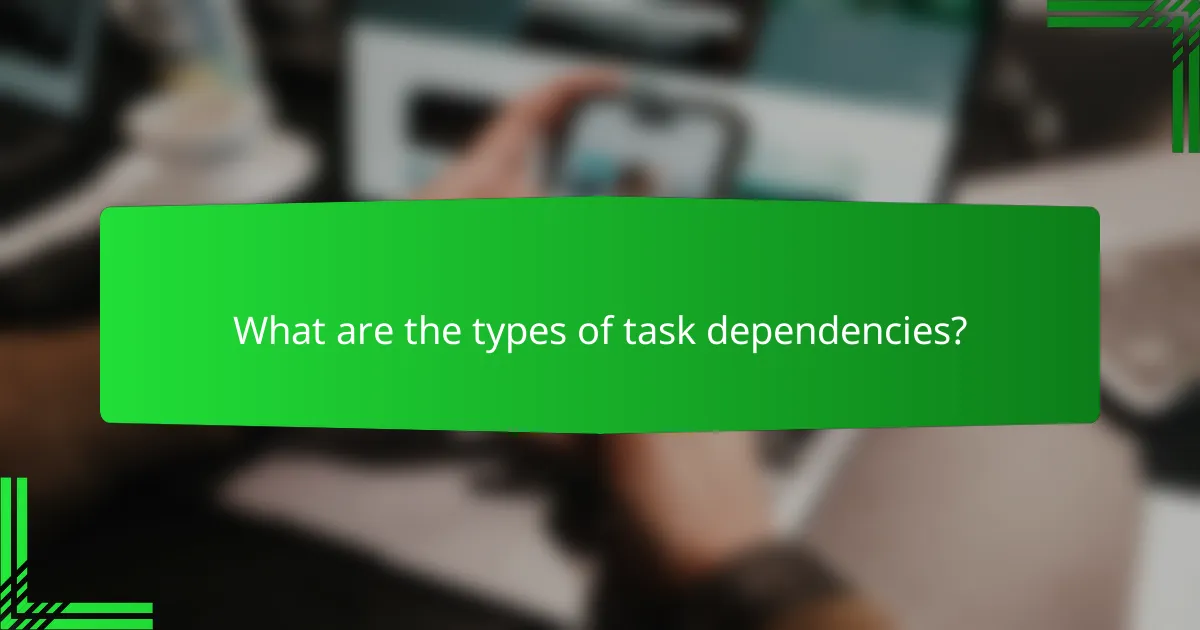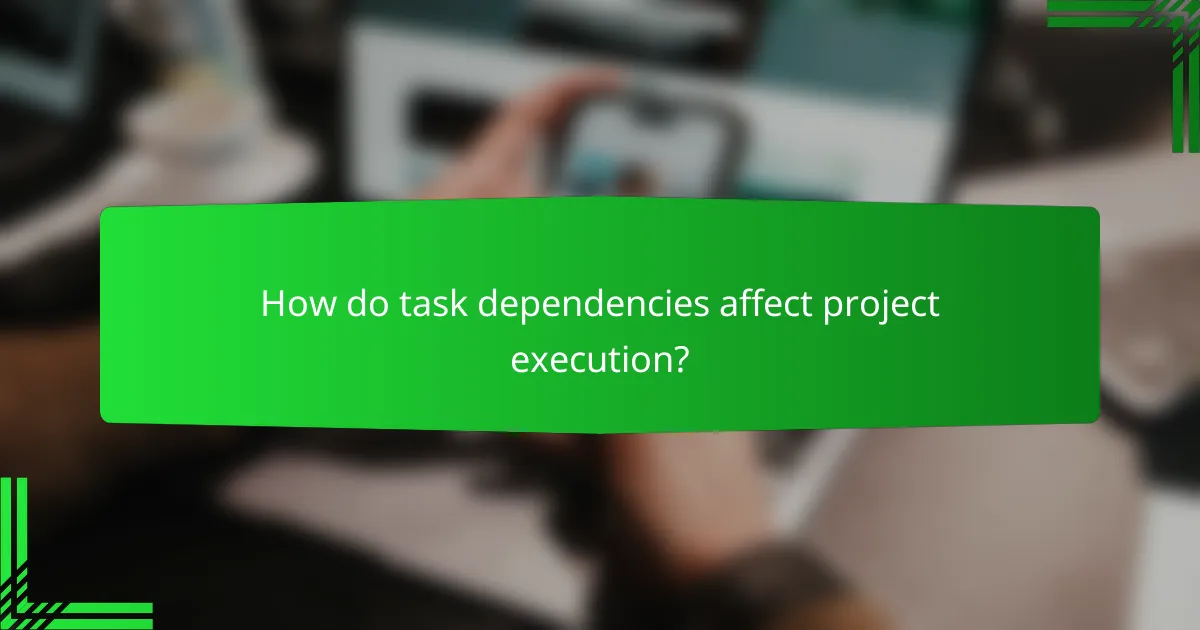Task dependencies play a crucial role in project planning and execution by defining the order and timing of activities. By understanding these relationships, project managers can effectively allocate resources, maintain timelines, and enhance team collaboration, ensuring that tasks are completed in a logical sequence. Identifying these dependencies is essential for successful project management, as it directly impacts scheduling and overall project efficiency.

How do task dependencies impact project planning?
Task dependencies significantly influence project planning by determining the sequence and timing of activities. Understanding these relationships helps project managers allocate resources effectively, maintain accurate timelines, and foster collaboration among team members.
Improved resource allocation
Identifying task dependencies allows project managers to allocate resources more efficiently. By recognizing which tasks rely on others, managers can prioritize resource distribution to critical activities, ensuring that essential tasks are completed on time.
For example, if Task B cannot start until Task A is finished, resources can be focused on completing Task A first. This strategic allocation minimizes downtime and maximizes productivity across the project.
Enhanced timeline accuracy
Understanding task dependencies is crucial for creating realistic project timelines. When dependencies are mapped out, project managers can better estimate the duration of each task and the overall project completion date.
Using tools like Gantt charts can help visualize these dependencies, making it easier to adjust timelines as needed. This approach reduces the risk of delays and ensures that stakeholders have a clear understanding of project progress.
Increased team collaboration
Task dependencies promote collaboration among team members by clarifying roles and responsibilities. When everyone understands how their tasks relate to others, it fosters a sense of accountability and encourages communication.
Regular check-ins and updates on dependent tasks can enhance teamwork. For instance, if a team member is aware that their work impacts another’s timeline, they are more likely to coordinate efforts to avoid bottlenecks.

What are the types of task dependencies?
Task dependencies are relationships between tasks that dictate the order in which they must be completed. Understanding the types of dependencies helps project managers effectively plan and execute projects by identifying how tasks interact with one another.
Finish-to-Start dependencies
Finish-to-Start (FS) dependencies are the most common type, where one task must be completed before the next can begin. For example, in construction, a foundation must be finished before framing can start. This type of dependency is crucial for maintaining a logical flow in project timelines.
When managing FS dependencies, ensure that the completion of the first task is clearly defined to avoid delays. A common pitfall is underestimating the time needed for the first task, which can cascade into subsequent delays.
Start-to-Start dependencies
Start-to-Start (SS) dependencies occur when two tasks can begin simultaneously, but one task must start before the other can proceed. For instance, in software development, coding can start as soon as the design phase begins, but testing cannot commence until coding has started. This allows for parallel work, increasing efficiency.
To effectively manage SS dependencies, coordinate the start times carefully to maximize resource utilization. Be cautious of potential bottlenecks if one task is delayed, as it can hinder the progress of the dependent task.
Finish-to-Finish dependencies
Finish-to-Finish (FF) dependencies require that two tasks must be completed together. For example, in a marketing campaign, the design of promotional materials must be finished at the same time as the final review of the campaign strategy. This ensures that all components are aligned for launch.
When dealing with FF dependencies, it’s essential to synchronize the completion timelines of both tasks. Misalignment can lead to rushed work or missed deadlines, so regular check-ins are advisable to keep both tasks on track.
Start-to-Finish dependencies
Start-to-Finish (SF) dependencies are less common and occur when one task cannot finish until another task has started. An example might be in a manufacturing process where the assembly of a product cannot be completed until the quality control process has begun. This type of dependency can create unique scheduling challenges.
Managing SF dependencies requires careful planning to ensure that the starting task is initiated on time. Delays in starting the prerequisite task can lead to extended project timelines, so proactive monitoring is crucial to mitigate risks associated with this dependency type.

How to identify task dependencies in a project?
Identifying task dependencies in a project involves determining which tasks rely on others to be completed before they can start. This process is crucial for effective project planning and execution, as it helps in scheduling and resource allocation.
Utilizing project management software
Project management software can streamline the identification of task dependencies by providing visual tools like Gantt charts and Kanban boards. These tools allow project managers to easily see which tasks are linked and how delays in one task can affect others.
When selecting software, look for features that support dependency tracking, such as drag-and-drop functionality for adjusting timelines. Popular options include Asana, Trello, and Microsoft Project, which can help visualize task relationships effectively.
Conducting stakeholder interviews
Stakeholder interviews are essential for uncovering task dependencies that may not be immediately obvious. Engaging with team members, clients, and other stakeholders can reveal insights about how tasks interconnect based on their expertise and experiences.
Prepare a set of targeted questions that focus on task sequences and resource needs. This approach can help identify potential bottlenecks and clarify expectations, ensuring that all dependencies are accounted for in the project plan.
Mapping out project workflows
Mapping out project workflows visually represents the sequence of tasks and their dependencies. This can be done using flowcharts or diagrams that illustrate how tasks connect and the order in which they must be completed.
Consider using tools like Lucidchart or Microsoft Visio for creating these maps. Ensure that the workflow includes all critical tasks and highlights dependencies clearly, which will aid in identifying potential risks and optimizing the project timeline.

What tools can help manage task dependencies?
Several tools can effectively manage task dependencies, ensuring that project timelines are adhered to and resources are allocated efficiently. Popular options include Asana, Microsoft Project, and Trello, each offering unique features suited to different project management styles.
Asana for task tracking
Asana is a versatile project management tool that excels in tracking task dependencies through its user-friendly interface. Users can create tasks, assign them to team members, and set due dates while linking dependent tasks to ensure proper sequencing.
To make the most of Asana, utilize its timeline feature to visualize how tasks relate to one another. This helps in identifying bottlenecks and adjusting timelines as needed. Regularly updating task statuses can prevent miscommunication and keep the project on track.
Microsoft Project for Gantt charts
Microsoft Project is renowned for its robust Gantt chart capabilities, which are essential for managing task dependencies in complex projects. Gantt charts visually represent tasks, their durations, and how they interconnect, making it easier to see the overall project timeline.
When using Microsoft Project, take advantage of its critical path feature to identify essential tasks that could impact project completion. Be mindful of the learning curve associated with this tool, as it may require some training for new users to navigate effectively.
Trello for visual task management
Trello is a highly visual tool that employs boards, lists, and cards to manage tasks and dependencies. While it may not have built-in dependency tracking like other tools, users can create checklists within cards to indicate task sequences and use labels to denote dependencies.
To enhance Trello’s functionality, consider integrating third-party power-ups that allow for better dependency management. Regularly review and update boards to reflect progress, ensuring that all team members are aligned on task priorities and timelines.

What are the best practices for managing task dependencies?
Managing task dependencies effectively is crucial for successful project planning and execution. Best practices include regularly updating timelines and communicating changes with the team to ensure everyone is aligned and aware of their responsibilities.
Regularly update project timelines
Regularly updating project timelines helps to reflect any changes in task dependencies, ensuring that all team members are aware of their deadlines. This practice allows for better resource allocation and can prevent bottlenecks that may arise from outdated information.
Consider using project management software that allows for real-time updates. For example, tools like Asana or Trello can help visualize task dependencies and timelines, making it easier to adjust as needed. Aim to review timelines at least weekly to stay on track.
Communicate changes with the team
Effective communication of changes in task dependencies is vital for maintaining team cohesion and productivity. When a task’s timeline shifts, informing all relevant team members promptly can prevent misunderstandings and ensure that everyone is working towards the same goals.
Utilize team meetings or digital communication platforms like Slack to share updates. Establish a protocol for notifying team members about changes, such as a dedicated channel for project updates. This can help minimize confusion and maintain momentum throughout the project lifecycle.

How do task dependencies affect project execution?
Task dependencies significantly influence project execution by determining the sequence in which tasks must be completed. Understanding these dependencies helps project managers allocate resources effectively and anticipate potential delays.
Influence on project delays
Task dependencies can lead to project delays when one task is reliant on the completion of another. For instance, if a critical task is delayed, all subsequent tasks that depend on it may also be pushed back, creating a domino effect throughout the project timeline.
To mitigate delays, project managers should identify and map out dependencies early in the planning phase. Utilizing tools like Gantt charts or project management software can help visualize these relationships and prioritize tasks accordingly.
Common pitfalls include underestimating the time required for dependent tasks or failing to account for potential risks. Regularly reviewing the project timeline and adjusting for any changes in task completion can help keep the project on track.
